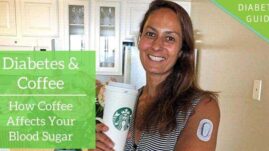Approximately 1.6 million Americans are living with type 1 diabetes, and 200,000 of those people are under 20 years old. Globally, type 1 diabetes accounts for as much as 10 percent of the 390 million people who live with any type of diabetes.
Living with diabetes comes with a variety of daily challenges, but thanks to progress in both insulin and technology, people with type 1 can live very healthy, full, long lives!
Let’s take a closer look at the symptoms, diagnosis, causes, and treatment options for type 1 diabetes.

Table of Contents
- What is type 1 diabetes?
- Causes of type 1 diabetes
- Symptoms of type 1 diabetes
- Factors that increase your risk of type 1 diabetes
- Diagnosing type 1 diabetes
- The “honeymoon phase” after your diagnosis
- When type 1 diabetes is misdiagnosed as type 2
- Treating type 1 diabetes
- Have your A1c measured every 3 to 6 months
- Complications of high blood sugar levels
- Managing low blood sugar levels
- Today, people are thriving with type 1 diabetes!
What is type 1 diabetes?
Type 1 diabetes is an auto-immune disease that develops when your immune system begins to attack and destroy the cells secreted by your pancreas that produce insulin. Eventually — over the course of weeks, months, or years — most people with type 1 diabetes will be producing little to no insulin.
But every mammal – including humans — needs insulin to stay alive. Without insulin, your body cannot make use of the glucose (sugar) in your bloodstream, and every single part of your body — your muscles, brain, nerves, blood vessels, etc. — relies on a second-by-second delivery of glucose to function and operate!
Research has found that people with type 1 diabetes struggle to produce normal amounts of amylin — which is another vital hormone that regulates blood sugar levels and your appetite after a meal. This can mean people with type 1 don’t feel as satisfied after eating along with difficulty controlling post-meal blood sugar levels.
Type 1 diabetes was once often referred to as “juvenile diabetes”, but this is a misleading name as people of any age can develop type 1 diabetes. In fact, the prevalence of type 1 diabetes is increasing for all age groups across the world.
Causes of type 1 diabetes
The exact cause of type 1 diabetes is still unclear. However, like most autoimmune diseases, it is likely that people are born with a predisposition to develop the disease someday. Most of us would never know this unless we were appropriately tested for autoantibodies earlier in life.
Research from Trial Net has found that people who develop type 1 diabetes generally develop at least 2 autoantibodies before the age of 5 years.
“Created by the body’s immune system, an autoantibody is a protein that attacks one or more healthy proteins,” explains Trial Net.
Trial Net offers free autoantibody testing to anyone under age 18 who is genetically related to a person with type 1 diabetes. Identifying autoantibodies early could mean potentially preventing the full onset of the disease thanks to Trial Net’s continued research.
It’s fairly common for the onset of type 1 diabetes to develop in the few weeks following an everyday virus like the flu or strep throat. While the body is attacking the flu virus, it almost over-reacts, in a way, and begins attacking the cells that produce insulin, too.
However, that doesn’t mean strep-throat or the flu caused diabetes. People with type 1 are likely born with a predisposition to someday develop the disease, and the everyday virus (or other stressful events like a car crash or even divorce) is simply the catalyst for the onset.
It is important to note that lifestyle factors like a poor diet or lack of exercise do not cause type 1 diabetes.
Symptoms of type 1 diabetes
The symptoms usually develop quickly — over the course of a few weeks — as your immune system gradually destroys more and more of the cells that are meant to produce insulin.
As your blood sugar levels rise higher and higher each week, your body begins to develop ketones which result from your body burning fat for fuel instead of glucose.
While low levels of ketones are harmless — like what you’d see in your bloodstream if you followed a ketogenic diet — the ketones that develop and accumulate when your body isn’t getting enough insulin increase to extremely dangerous levels that can lead to stroke, coma, and death.
Left unnoticed or untreated, the dangerously high blood sugar and ketone levels that develop within even one month of having the disease can be fatal.
Fortunately, most cases of type 1 diabetes are caught before this happens due to its very consistent symptoms.
The most common symptoms include
- Sudden extreme thirst
- Abnormally frequent need to pee
- Abnormal fatigue and tiredness
- Unexplained weight loss
- Blurred vision
- Yeast infections in women
- Dry bowel movements in diapers of young children
Earliest symptoms
- Increased thirst
- Increased need to urinate
- Blurry vision
- Headaches
- Increased hunger
Later symptoms
- Sour fruit smell on your breath
- Lethargy — very heavy feeling in your limbs
- Yeast infections (in men or women)
- Dry mouth
- Weight-loss
- Shortness of breath
- Weakness
- Confusion/difficulty concentrating
- Nausea
Emergency symptoms
If you experience these symptoms at any point before or after your diagnosis, you should contact your healthcare team or visit your local emergency department immediately.
- Vomiting
- Abdominal pain
- Coma
- Ketones in your urine
- Diabetic ketoacidosis (DKA)
The symptoms can also develop after your diagnosis when your blood sugars are consistently high or suddenly extremely high. These symptoms should never be ignored. Any sign of the “emergency” symptoms should be managed by an immediate trip to the emergency department.
Factors that increase your risk of type 1 diabetes
Trial Net lists the following as factors that increase your likelihood of developing type 1 diabetes:
Family history: You are 15 times more likely to develop type 1 diabetes if you have a genetic relative with the disease.
Genetics: Specific genes increase a person’s risk of developing type 1 diabetes — this cannot be determined without detailed testing.
Autoantibodies: Diabetes-related autoantibodies signal an increased risk of type 1 diabetes. TrialNet screening can detect these autoantibodies years before symptoms appear if you enroll yourself or your child in their program.
Geography: Research has found that the further away you live from the equator, the more common type 1 diabetes is. “People living in Finland have the highest incidence of type 1 diabetes in the world — about two to three times higher than those who live in the United States.”
Race/Ethnicity: While type 1 diabetes develops in every ethnicity, Caucasians (white) and Europeans have the highest risk.
Age: While type 1 can develop at any age, it still develops most commonly in those under 18 years old.
Diagnosing type 1 diabetes
The diagnosis results from two very simple tests:
- Testing your urine for ketones
- Testing your blood sugar level
By the time most people go to their doctor because of the symptoms of type 1 diabetes, blood sugar levels are well above 300 mg/dL.
Type 1 diabetes can also be pinpointed earlier — but this is most likely if another family member has type 1 diabetes and you identify subtle early symptoms along with using their blood glucose meter.
Any of the following blood sugar readings should make you visit a doctor immediately to be tested for autoantibodies:
- HbA1c (average blood sugar level): 6.5 percent or higher
- Fasting blood sugar: 126 mg/dL or higher
- 2 hours after eating: 200 mg/dL or higher
After your official diagnosis, you may be admitted to the intensive-care unit for a couple of days to receive intravenous saline and insulin to stabilize your blood sugar levels and your body’s overall fluid balance.
The higher your blood sugar and ketone levels are when you’re diagnosed, the more likely you may need those intravenous treatments.
If your diabetes is identified and diagnosed earlier, when blood sugar levels aren’t as high, you’ll likely be given an outpatient diabetes education on how to take insulin and work with your new healthcare team intensely for the first few weeks and months to help stabilize your blood sugars.
Learning how to manage type 1 diabetes is a life-long process. It isn’t learned in one day or even a few months. This is why it’s important to have a great healthcare team and take it day by day.
The “honeymoon phase” after your diagnosis
The “honeymoon phase” describes a period of time after your diagnosis when your pancreas is still producing a significant amount of insulin.
But over time — again, over the course of a few months or even a full year — you’ll likely see your insulin needs gradually rise, and your blood sugars more easily affected by high-carbohydrate meals.
Work closely with your healthcare team to gradually adjust your insulin doses as your pancreas’ insulin production declines.
When type 1 diabetes is misdiagnosed as type 2
While type 1 diabetes does develop in adults, mainstream healthcare still thinks of it as “juvenile diabetes” that develops in childhood. This means that some adults with type 1 diabetes are misdiagnosed as type 2 diabetes for the first few years of the disease.
If you’ve been diagnosed with type 2 and you suspect you have type 1, ask to have your autoantibody levels tested. This test will reveal if your body is struggling with an autoimmune disease versus a metabolic disorder.
Type 1.5 diabetes (also known as LADA: Latent Autoimmune Diabetes in Adults) is also commonly misdiagnosed as type 2. Type 1.5 is essentially a very slowly progressing form of type 1 diabetes that can look like type 2 at first.
You may have been misdiagnosed with type 2 diabetes, and have type 1.5 diabetes if:
- You maintain a reasonably healthy weight
- You’re over the age of 30
- You didn’t require insulin to maintain healthy blood sugar levels for the first 6 months after your diagnosis
- Long-term, oral medications do not improve your blood sugar levels
- You don’t have other metabolic syndrome conditions like high cholesterol or high blood pressure.
- You have no family history of type 2 diabetes
Talk to your healthcare team to get the support you need!
Treating type 1 diabetes
Treating — and managing — type 1 diabetes on a daily basis focuses first on insulin.
Whether you take multiple daily injections (MDI) or use an insulin pump, you will need to manage your insulin doses carefully every single day.
You will manage your insulin based on your blood sugar levels, which need to be monitored throughout every day with a traditional glucose meter or a continuous glucose monitor.
Monitoring your blood sugar levels closely every day is critical because they can fluctuate easily based on your body’s sensitivity to insulin, every food or beverage you choose to consume, your physical activity level, hormone fluctuations due to natural occurrences like stress or your menstrual cycle, and the daily challenge of balancing all of these things at any given time.
Once diagnosed, blood sugar goals for a person with type 1 or type 2 diabetes are:
- Between 80 and 130 mg/dL “fasted” (before meals)
- Less than 180 mg/dL within two hours after meals
It’s important to note that very few people with type 1 diabetes are able to stay within that tight range all the time. Managing type 1 diabetes is a constant juggling act of insulin, food, activity, stress, and other hormones that impact blood sugar levels.
Healthy blood sugar levels in a non-diabetic are:
- Between 80 and 120 mg/dL for people aged 59 and younger with no additional medical conditions
- Below 100 mg/dL when fasted (before eating)
- Between 100 and 140 mg/dL for people age 60 and older if they have additional health conditions like heart disease, kidney disease, hypoglycemia, etc.
These non-diabetic blood sugar levels are merely goals for those of us with diabetes but it’s unrealistic to expect to stay in this range all the time. Instead, use these numbers are motivators for your daily care and to help you understand what your body’s ideal blood sugar level range is for optimal long-term health.
Multiple daily injections (MDI)
If you’re taking your insulin with a syringe or insulin pen, you will need a long-acting (basal) insulin that’s taken once or twice a day to replicate the way your pancreas would normally release a constant drip, drip, drip of insulin all day and all night long.
Then, you will need a fast-acting (or “rapid”) insulin for meals, and for corrections when your blood sugar is high. Fast-acting insulin replicates the way your pancreas would normally release a large bolus of insulin to manage the food you eat.
Insulin pumps or pods
People using pumps or pods to deliver their insulin will only use fast or rapid-acting insulin that is programmed with your healthcare team’s support to deliver insulin that drip, drip, drip all day long as well as larger boluses of insulin for meals and corrections.
Continuous glucose monitors
Continuous glucose monitors (CGMs) are one of the newest forms of diabetes technology. By wearing a small sensor in the body fat on your belly, arm, or thigh, blood sugar levels are reported every 5 minutes to a receiver.
This technology gives many patients with type 1 diabetes far more peace of mind, increased safety during sleep and exercise, reductions in both high and low blood sugars, and the ability to manage blood sugars in a tighter range.
Other medications used in treating type 1 diabetes
People with type 1 diabetes can also take medications originally intended for type 2 diabetes that assist with insulin resistance, glucose released by the liver, and our body’s lack of the hormone amylin.
Unfortunately, these medications are not always covered by insurance because they are intended for type 2 diabetes. Work with your healthcare team to discuss your options.
Nutrition
According to the American Diabetes Associations’ 2019 nutrition consensus report, everyone’s body responds differently to different types of foods and diets, so there is no single “magic” diet for Diabetes.
However, while people with type 1 diabetes can technically “eat anything” by counting the carbohydrates and accounting for high quantities of fat or protein, the diabetes world is gradually accepting that a diet with fewer carbohydrates can be very helpful.
By eating a whole-food diet that focuses on vegetables, proteins, and fats, with a reduction of starches, sugars, and even fruit, blood sugar levels become easier to manage because the need for insulin decreases when carbohydrate consumption decreases.
Exercise and other variables
The complicated part of type 1 diabetes is never-ending because so many aspects of daily living and the normal functions of the human body can raise or lower your blood sugar levels and your insulin needs.
Even if you were to eat the same foods every single day, the other variables that impact the body’s blood sugar levels and insulin needs would require just as much attention each day.
Exercising, for example, with type 1 diabetes is remarkably complex. Simply changing the type of exercise and the time of day you perform that exercise will drastically change how you must prepare your blood sugar to prevent high or low blood sugars during and after your workout.
On the positive side, exercise is the most effective way to increase your insulin sensitivity, which means that people who exercise regularly typically need less insulin.
Weight-loss and weight-management
Simply put, the healthier your overall body weight is, the less insulin resistance you’ll struggle with, and the healthier your entire body will be! Losing weight and maintaining a healthy weight is a key part of living well with type 1 diabetes.
Losing weight with diabetes isn’t always easy. While it starts with making healthy food choices and exercising regularly, patients taking insulin and other medications that lower blood sugar need to be very careful.
Even if you lose 3 or 5 pounds, you’ll find your insulin or other medication needs will drop, too. If you don’t make changes to your medication dosages, you may experience severe low blood sugars. It’s important, especially for anyone taking insulin, to make these gradual adjustments as you gradually lose weight.
Have your A1c measured every 3 to 6 months
Your A1c is a very useful way of getting an overall idea of where your blood sugars are at every day. Also known as your HbA1c, this test gives you a percentage that translates to a general blood sugar range.
You can use this easy A1c/ eAG calculator from the American Diabetes Association to instantly translate your latest A1c result to an eAG.
12% = 298 mg/dL (240 – 347)
11% = 269 mg/dL (217 – 314)
10% = 240 mg/dL (193 – 282)
9% = 212 mg/dL (170 –249)
8% = 183 mg/dL (147 – 217)
7% = 154 mg/dL (123 – 185)
6% = 126 mg/dL (100 – 152)
5% = 97 mg/dL
The American Diabetes Association (ADA) recommends achieving and maintaining an A1c below 7 percent for optimal health and prevention of diabetes-related complications.
Let’s take a look at what happens when blood sugar levels are too high consistently.
Complications of high blood sugar levels
Left untreated, high blood sugars will wreak havoc on your entire body, because glucose will build up in your bloodstream and essentially rot the vital nerve endings throughout your entire body.
These are some of the most common complications that can result from consistently high blood sugar levels:
- Retinopathy in your eyes, which can lead to blindness
- Neuropathy in your fingers, toes, legs, feet
- Difficulty healing, which can lead to infections and amputation
- Nephropathy in your kidneys
- Gum disease and other oral health issues
- Gastroparesis in your digestive system
- Hair-loss
- Coma
- Death
High blood sugar levels become immediately dangerous when:
- You’re high for a consistent period of time, even when you wake up in the morning
- You’re running above 180 mg/dL on a regular basis
- You’re running above 250 mg/dL on a regular basis — very dangerous
High blood sugars are serious and can severely impact your health in the short term and long-term. Talk to your healthcare team immediately if you believe your blood sugars are consistently running higher than your goal range.
Work with your healthcare team to make small adjustments in your insulin doses and other medications in order to make staying within your goal range easier.
Our insulin needs fluctuate and change based on a variety of variables, so we need to adjust based on our blood sugar levels.
Managing low blood sugar levels
A low blood sugar (or hypoglycemia) is defined by blood sugar levels below 70 mg/dL. For people with type 1 diabetes, it’s very easy to experience low blood sugar from getting even ½ a unit more insulin than you needed with lunch.
There are several telltale signs that your blood sugar has dropped below a safe level. The ADA lists the following as symptoms of low blood sugar:
- Feeling shaky
- Being nervous or anxious
- Sweating, chills, and clamminess
- Irritability or impatience
- Confusion
- Fast heartbeat
- Feeling lightheaded or dizzy
- Hunger
- Nausea
- Color draining from the skin (pallor)
- Feeling Sleepy
- Feeling weak or having no energy
- Blurred/impaired vision
- Tingling or numbness in the lips, tongue, or cheeks
- Headaches
- Coordination problems, clumsiness
- Nightmares or crying out during sleep
- Seizures
If you are experiencing low blood sugars regularly — multiple times per week — that you don’t understand the exact cause of, talk to your healthcare team about making adjustments in your insulin doses.
Frequent hypoglycemia can lessen your body’s ability to sense the symptoms, which puts you at risk for severe hypoglycemia which can lead to a seizure, coma, or death.
Today, people are thriving with type 1 diabetes!
Despite how incredibly serious and demanding living with type 1 diabetes may be, people with this disease can thrive when they do their best to manage their blood sugars and make healthy choices around food, exercise, and other lifestyle habits.
People with type 1 diabetes can become professional athletes, pursue pregnancy, and even be Supreme Court judges!
As long as you give your type 1 diabetes the attention it needs, the possibilities for your life are endless.




Rajat Garg
Great Article.
Thanks for such an informative post Christel. Many people are suffering from diabetes nowadays as it has become a common problem. I hope your article will help many of them and will create awareness among many young people like me.